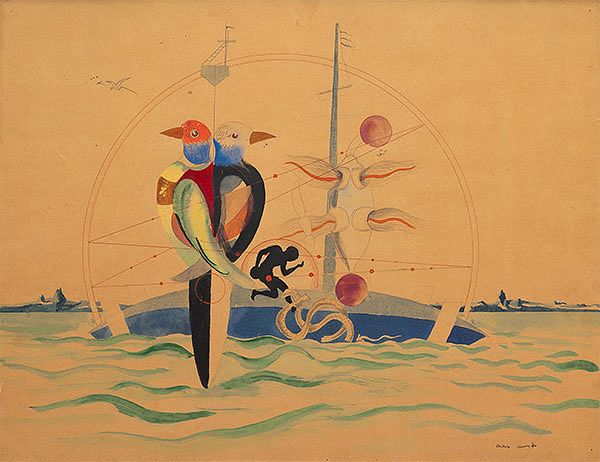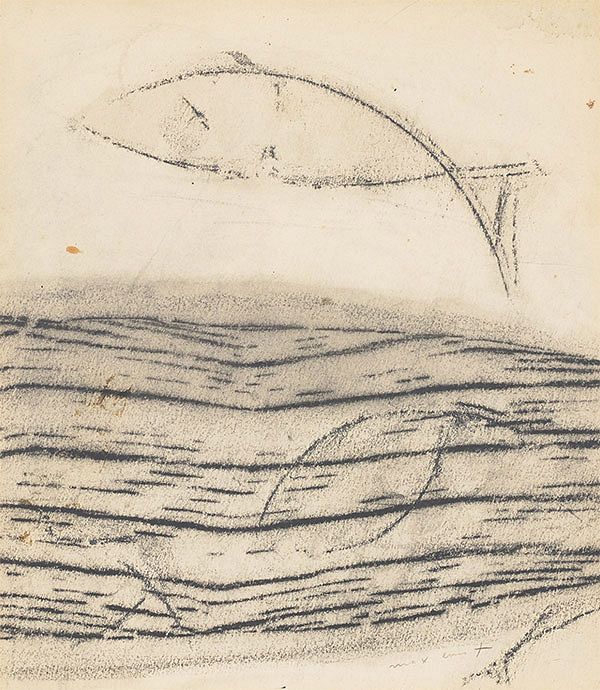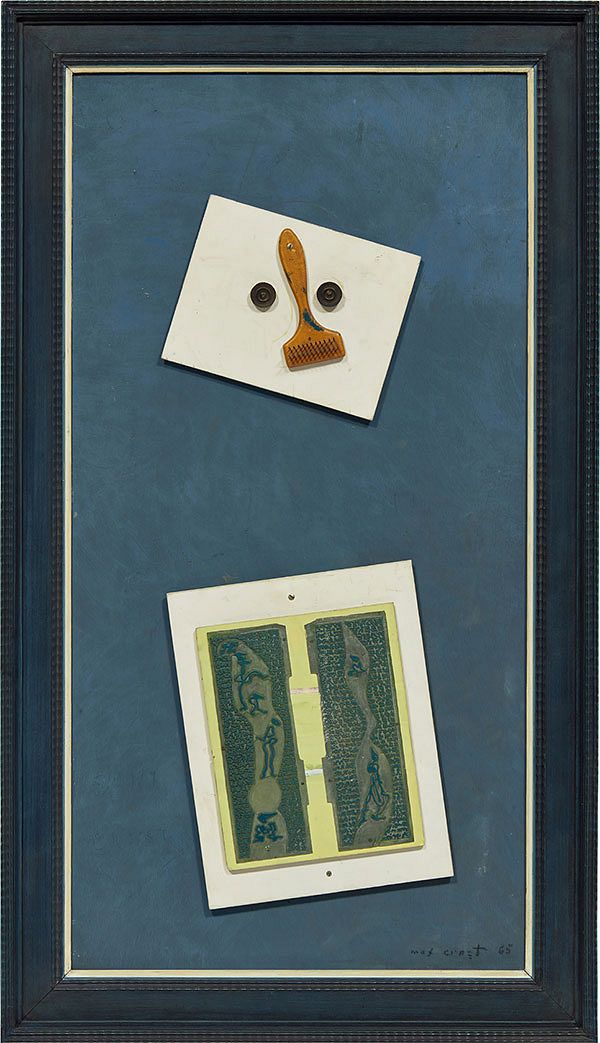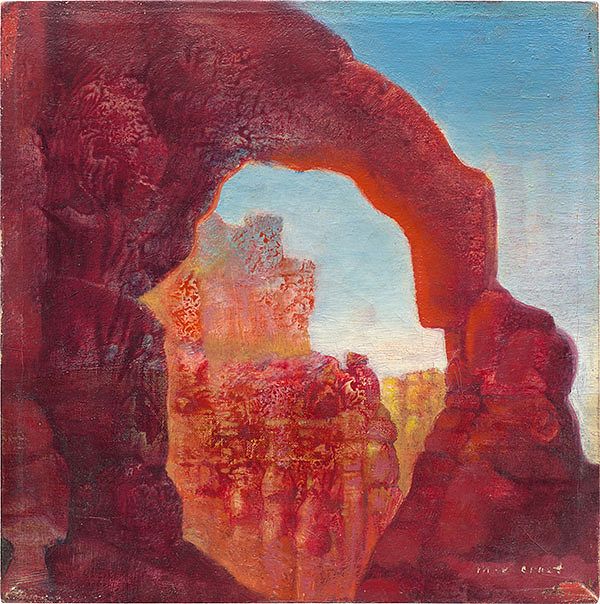Max Ernst, Delicate Arch (Zion National Park), 1936. 20th Century & Contemporary Art, New York.
The practice of art and the science of the cosmos combined in the surreal works of Max Ernst through his creative fascination with German astronomer Wilhelm Tempel. In 1861, Tempel discovered a planetoid and named it after Maximillian II, King of Bavaria. Ernst, in turn, would become engrossed in Tempel's unique approaches to astronomy, finding a kindred spirit in the relationship between science and the surreal; in the exploration of the limits of human perception of the universe. The stars continued to align when Ernst and director Peter Schamoni collaborated for a 1967 documentary on the life and work of Tempel, The Unlawful Practice of Astronomy, which began an artistic relationship betwen the director and the artist. Through his close friendship with Max Ernst, Peter Schamoni assembled an exceptional collection that serves as a lasting memento and retrospective of one of the most significant artists of the 20th century.
Written by Ravit Helled
We are part of the cosmos, but we are small and the universe is huge. It is important to open our eyes and hearts to better understand our place in the the grand picture, how insignificant, fragile and short-lived we are, how fascinating space is, and how we can be inspired by it. Perhaps astronomers and artists are not that different after all — they both aim to see beyond the visible and find a meaning to what’s around us.

Max Ernst, Ohne Titel (les hommes ne le sauront jamais), circa 1921. 20th Century & Contemporary Art, New York.
1926: A Breakthrough
Although the Sun is just one of billions of similar stars in our galaxy, it is special to us because it provides the energy for nearly all living things on Earth. Our Sun has shone for four and half billion years and will continue for another seven billion. Its main source of energy was a mystery until Albert Einstein showed that matter itself is pure energy and Arthur Eddington demonstrated how atoms could fuse together in stars, liberating this energy. In 1926, Eddington published calculations that revolutionized our understanding of the structure of stars and how they evolve in time. He showed that there is an intricate balance between gravity that holds stars together and nuclear energy that prevents them from collapsing. This work led to the relation between the masses of stars and their brightness, allowing astronomers to estimate their ages. This in turn led to the first limits on the age of our universe, which had to be older than the oldest stars that are 13 billion years old. The leap in our understanding of the workings of stars was a crucial milestone for astrophysics and our investigation of the cosmos.

Max Ernst, Kachina, le chien de Peggy Guggenheim, circa 1942. 20th Century & Contemporary Art, New York.
1930: Planet X
At the beginning of the 20th century, astronomer Percival Lowell thought that the irregular movements of the outer planets Uranus and Neptune could be due to a more distant, hypothetical planet X. In 1930, 14 years after his death, Pluto was discovered at the Lowell Observatory and officially added as the ninth planet of the Solar System. Its status as a planet lasted over seventy years, until the 2005 discovery of a larger object beyond the orbit of Neptune known as Eris, which initiated discussions on how planets in the solar system should be defined. After vivid and emotional debates culminating in a vote among professional astronomers, the International Astronomical Union (IAU) announced in 2006 that Pluto was no longer a planet, and classified it instead as a “dwarf planet.” One of the criteria for an object to be a planet is that it has to have cleared its planetary environment — in other words, it must be the dominant object in its orbital region. This is not the case for Pluto, which is part of the Kuiper belt, a region full of large rocky, icy objects beyond Neptune’s orbit. It was only in 2015 that we had our first close-up images of Pluto’s surface, showing that it is active with a liquid ocean that could even host life.

Max Ernst, Hawaï, 1952. 20th Century & Contemporary Art, New York.
1957-58: The Age of Exploration Begins
1957 represents the dawn of the Space Age. That year, the Soviet space program launched Sputnik 1, the world’s first artificial satellite, triggering the space race. The following year, the United States launched its first satellites into space, including Vanguard 1, which still orbits the Earth today. Political dimensions aside, the space race triggered important technological and scientific developments, from communication and Earth monitoring satellites to landing humans on the moon and the remote exploration of our solar system. Today there is a new space race, as many nations plan return trips to the moon and beyond. We also have private companies and the beginnings of space tourism. These breakthroughs raise their own important questions, such as who owns space? What are we capable of achieving in terms of space exploration? Will we colonize space? How are we going to be affected by these efforts? Are there limits we should not cross?

Max Ernst, Déchets d'oeuvres, 1968. 20th Century & Contemporary Art, New York.
1969: To the Moon and Beyond
Our planetary system is the remnant of the formation of the Sun. While today we know that planetary systems are common in the galaxy, just about two decades ago, the Solar System was the only known planetary system. Already in the late 1700s it was suggested that our planetary system was formed as a result of the collapse of a gaseous cloud. The collapse of this cloud was thought to lead to the formation of the young Sun, which was surrounded by a disk, from where the planets formed. Only in 1969 did the Russian astronomer Victor Safronov publish his theory on the “Evolution of the protoplanetary cloud and formation of the earth and the planets” in Russian. This work, which introduces key questions linked to the origin of planets, was been translated into English three years later. This theory represents the beginning of extensive research on the origin of the Solar System and planetary systems around other stars.

Max Ernst, Portrait de Ernst Wilhelm Leberecht Tempel, 1965. 20th Century & Contemporary Art, New York.
1974: A Message to the Stars
The question of whether extraterrestrial life exists has been keeping scientists and philosophers busy well before we detected the first extra-solar planet. Only recently we have learned that small planets are common in the galaxy, suggesting that life in the universe is not a rare phenomenon, at least statistically speaking.
In 1974, a message to space, known as the Arecibo message, was sent to the star cluster M13, near the edge of the Milky Way galaxy. The Arecibo message included 1,679 binary digits, and was sent from the Arecibo radio telescope in Puerto Rico. The message included basic information about human race, such as the fundamental chemicals of life, the formula for DNA, and graphics of the Solar System and the Arecibo telescope. The search for intelligent extraterrestrial communications in the universe and Earth-like planets are ongoing, and we seem to be closer than ever to finally answer the question: “Are we alone?”
Ravit Helled is a Professor of Theoretical Astrophysics at the Institute for Computational Science, Center for Theoretical Astrophysics & Cosmology, University of Zurich. Helled’s scientific work concentrates on planet formation and evolution, planetary interiors, and extrasolar planets. She is an international expert in planetary modeling, and uniquely addressing the link between planetary formation, evolution, and internal structure, as well as linking exoplanetary studies with solar system science. Professor Helled is strongly involved in space exploration and is a key member in several ESA and NASA space missions.
Discover More from 20th Century & Contemporary Art >
Recommended Reading
Maximiliana: Max Ernst from the Collection of Peter Schamoni >
The Art Lover's Guide to Porto >
